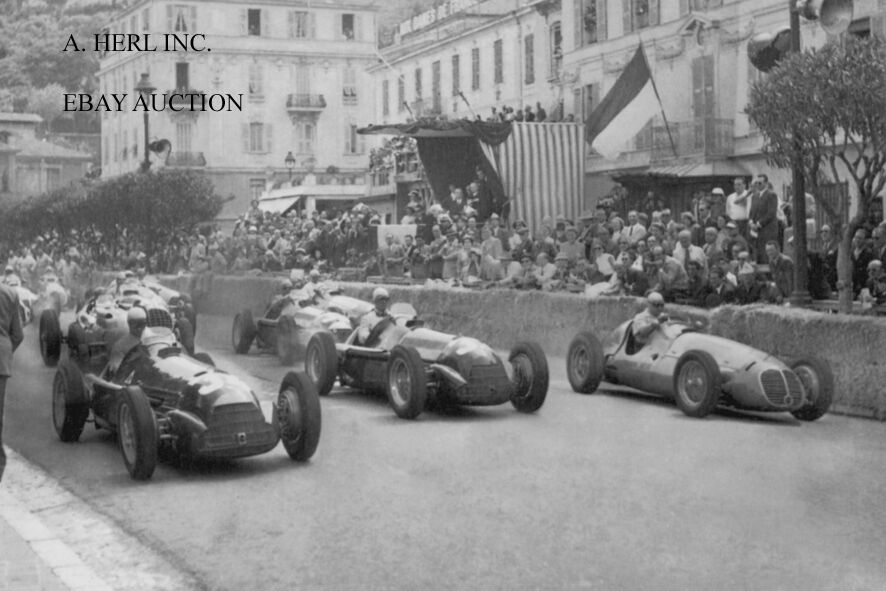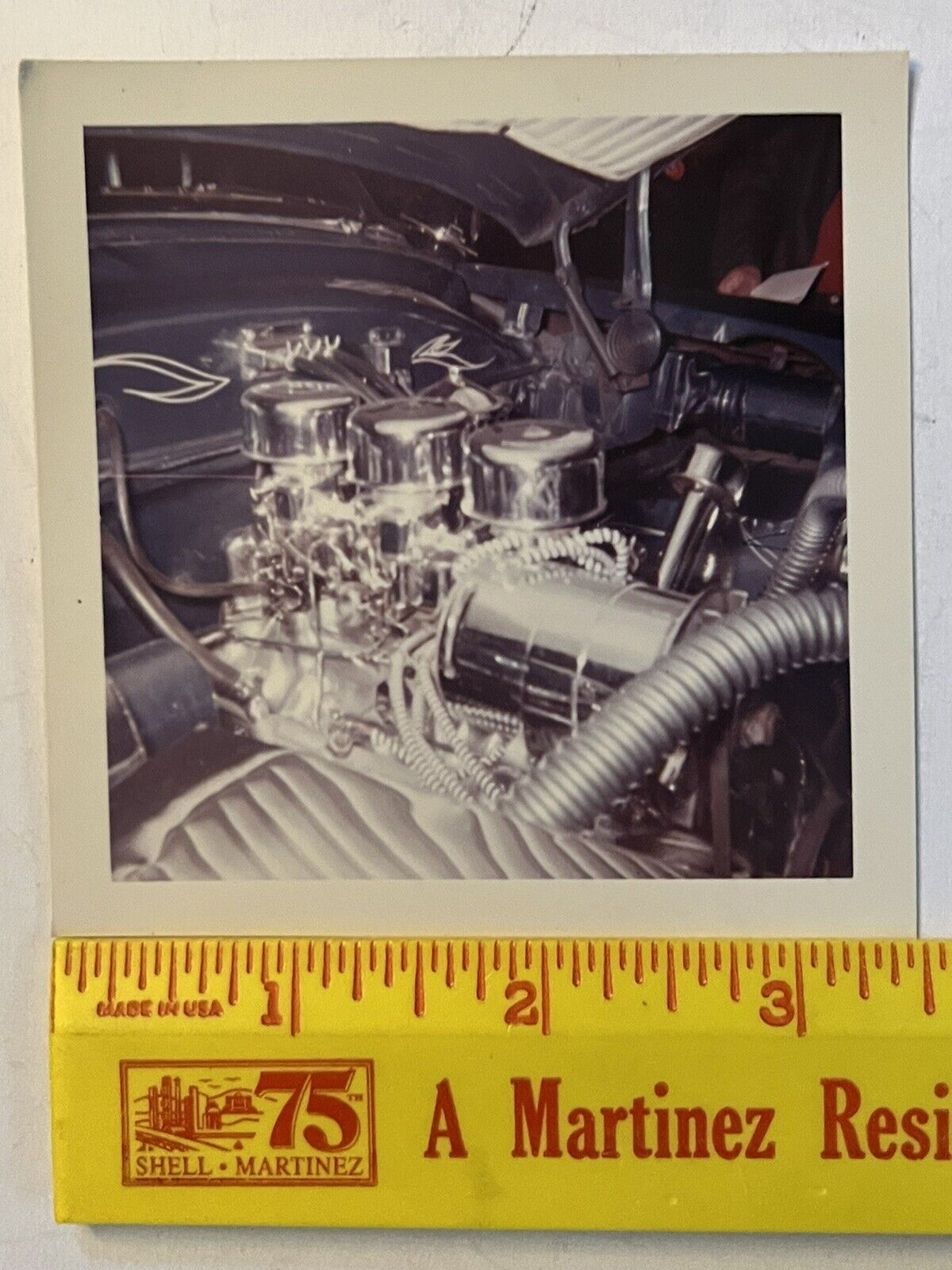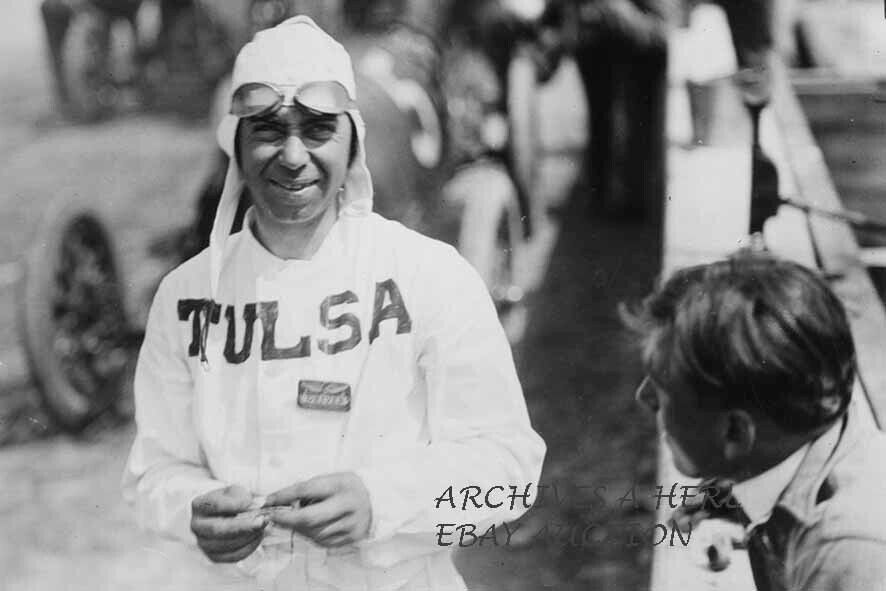-40%
Alfa Romeo 158 & Maserati 4CLT- start of the 1950 Monaco Formula 1 Grand Prix -
$ 5.14
- Description
- Size Guide
Description
A superb and rare photo of the starting line of the1950
edition of the famous
Monaco Grand Prix
. The photo was taken during the start of the race on
the
21ST of May, 1950
.
From right to left we see the
Maserati 4CLT
(nr. 2) of
Froilan Gonzalez
, the
Alfa Romeo 158
(nr. 32) of
Giuseppe Farina
and the
Alfa Romeo 158
(nr. 34) of the
race winner Juan Manuel Fangio
.
Juan Manuel Fangio would win the race
, and he would score the fastest lap with an average speed of
64.085 mph
(
103.135 km/h
). Farina and Gonzalez collided during the first lap, both were unable to continue the race. Fangio won the race no less then a full lap in front of Alberto Ascari (Ferrari type 125) and with a two lap lead on the 3RD finisher, Louis Chiron (Maserati 4CLT)!!
Both racewinner
Fangio
and
Farina
are seen accelerating away from the starting strip in an
Alfa Romeo 158
. This car is also known as the Alfetta (Little Alfa in Italian). It is amongst the outmost successful racing cars ever produced. The 158 and its derivative, the 159, took 47 wins from 54 Grands Prix entered. It was originally developed for the pre-World War II voiturette formula (1937) and has a 1.5 litre straight-8 supercharged engine. Following World War II, the car was eligible for the new Formula One introduced in
1947. In
the hands of drivers such as Nino Farina, Juan-Manuel Fangio and Luigi Fagioli, it dominated the first two seasons of the Formula One World Championship.
The first version of this successful racing car, the 158, was made during 1937/1938. The main responsibility for engineering was given to Gioacchino Colombo. The car's name refers to its 1.5 litre engine and eight cylinders. The voiturette class was for racing cars with 1.5 litre engines, standing in the same relation to the top 'Grand Prix' formula (usually for
3 litre
engines) as the GP2 series does to Formula One today. Alfa's
3 litre
racing cars in 1938 and 1939 were the Tipo 308, 312 and 316.
The 158 debuted with the works Alfa Corse team at the Coppa Ciano Junior in August 1938 at
Livorno
,
Italy
, where Emilio Villoresi took the car's first victory. At that time the 1479 cc engine produced around 200 bhp (150 kW) at 7000 rpm with the help of a single-stage Roots blower. More success came at the Coppa Acerbo, Coppa Ciano and Tripoli Grand Prix in May 1940. Soon World War II stopped development of the car for six years. After the war the engine was developed further to push out 254 bhp (189 kW) in
1946. In
1947, the Alfetta became eligible for the newly-created Formula One. The new rules allowed 1500 cc supercharged and 4500 cc naturally aspirated engines. The 158 was modified again, this time to produce over 300 bhp (220 kW) and was denoted as Tipo 158/47. The car made a tragic debut in the 1948 Swiss Grand Prix where Achille Varzi lost control of his car and was killed. Another loss for the team came in practice for the 1949 Buenos Aires Grand Prix, where Jean-Pierre Wimille was killed in an accident (driving with Simca-Gordini). The car won every race in which it competed during 1950; it was incredible that a car which had originated in 1938 was so victorious. The Alfa Romeo team included talented drivers such as Giuseppe Farina and Juan Manuel Fangio, the latter of whom later won the World Drivers' Championship five times. At the end of the 1950 season, a further updated version known as the 159 was produced. This version had reworked rear suspension, the old swing axle was replaced with a De-Dion axle and the engine produced around 420 bhp (313 kW) at 9600 rpm. For their last World Championship race (until 1979), the 1951 Spanish Grand Prix, Alfa Romeo introduced a new evolution version known as the 159M, the "M" standing for Maggiorata ("improved"). The 1952 World Drivers' Championship was run to Formula Two regulations, so the 159 became obsolete. The car's last Grand Prix win came in 1953 at Merano Grand Prix,
Italy
.
Gonzalez
is seen accelerating away from the starting strip in a
Maserati 4CLT
. The
Maserati 4CL
and its derived sister model the
Maserati 4CLT
were single-seat racing cars that were designed and built by the prestigious Italian Maserati car firm. The 4CL was introduced at the beginning of the 1939 season, as a rival to the Alfa Romeo 158 and various ERA models in the voiturette class of international Grand Prix motor racing. Although racing ceased during World War II, the 4CL was one of the front running models at the resumption of racing in the late 1940s. Experiments with two-stage supercharging and tubular chassis construction eventually led to the introduction of the revised 4CLT model in 1948. The 4CLT was steadily upgraded and updated over the following two years, resulting in the ultimate 4CLT/50 model, introduced for the inaugural year of the Formula One World Championship in
1950. In
the immediate post-war period, and the first two years of the Formula One category, the 4CLT was the car of choice for many privateer entrants, leading to numerous examples being involved in most races during this period. In the late 1930s, continued rapid development in the increasingly competitive international voiturette class, and the introduction of the Alfa Romeo 158 and ERA B- and C-type models, forced the Maserati brothers into designing a new, square-bore, inline-4 cylinder engine. This new engine developed 30-50bhp more than the previous inline-6, the increase mostly achieved through an increase to four valves per cylinder, coupled to the use of a more powerful supercharger and a small increase in the compression ratio. Following customary Maserati practice, the engine was mounted into a chassis design almost identical to that of the 4CL's predecessor: the Maserati 6CM. Conventional in its architecture, twin box-section spars ran the length of the car joined, ladder-fashion, by smaller cross members, although the 4CL design did incorporate more aluminium componentry than its forbear. Although near-identical in its wheelbase, the 4CL's track was a full 5cm wider than the 6CM, and sat lower thanks to repositioned spring hangers. Enveloping this rather conservative chassis was a low, curvaceous alloy-panel body, built in-house by Maserati. Maserati also built a streamlined version of the 4CL from the outset. Continued engine development, in response to Alfa Romeo's post-war introduction of two-stage supercharging, began to expose weaknesses in the chassis design. In an attempt to improve torsional rigidity Maserati began to experiment with tubular section chassis members. These experimental models ran alongside conventional 4CLs throughout the 1947 season, and eventually led to the introduction of the 4CLT in 1948.
Both the
Maserati 4CL
as the
4CLT
have a very interesting
racing history
. In the hands of Luigi Villoresi the streamliner took pole position on the 4CL's race debut at the 1939 Tripoli Grand Prix, ahead of Mercedes' brand new W165s. However, both it and two of the three conventional 4CLs entered retired early in the race with engine troubles, leaving the Silver Arrows to take the victory. Embarrassingly for the works team, following this disappointing debut the 4CL's first taste of victory came in the hands of privateer Johnnie Wakefield at the Naples Grand Prix, two races later. Through the remainder of 1939 voiturette races
Wakefield
took two further victories, and the works' 4CLs picked up another two, before the outbreak of war curtailed international competition. Villoresi took the 4CL to victory in the 1940 Targa Florio, but with entry restricted to Axis countries, and only Maserati fielding a factory team, the opposition was hardly World Class. On the resumption of competition in 1946 the Maserati 4CL proved the class of the field. Luigi Villoresi immediately returned to winning ways, taking victory in the first race following the cessation of hostilities: the 1946 Nice Grand Prix. Tazio Nuvolari and Giorgio Pelassa both took wins in 4CLs, but it was Raymond Sommer and his 4CL who dominated the season. 1947 would prove to be the 4CL's most successful season and, despite Alfa Romeo fielding the revamped 158 and new 308, Maserati drivers picked up 10 individual race victories. After the replacement of the factory team's 4CLs by the new 4CLT, many examples of the older cars found their way into privateer hands. It was owing to the 4CL's popularity with privateer entrants that many were still being run in top-flight competition at the outset of the Formula One World Championship in 1950.
The 4CLT.
Chassis and engine changes made to the experimental 4CLs eventually coalesced into the 4CLT, the appended T denoting its tubular chassis. The improvements in torsional rigidity that the tubular construction brought were required to counteract the increases in torque and power resulting from the twin-supercharger upgrade of the elderly inline-4 engine. Power was up to approximately 260bhp, from the 4CL's 220. Other changes included the use of roller bearings for the crankshaft, forged (rather than cast) rear suspension components, and the chassis was designed to run with hydraulic dampers from the outset.
1950 saw the introduction of the FIA Formula One World Championship. In response to improvements to the Alfa 158 and the already competitive Ferrari and Talbot, Maserati again upgraded the 4CLT's engine. A multi-part crankshaft, lightened and balanced rods, a more powerful pair of superchargers and changes to the ignition timing took engine output up to 280bhp. Coupled to shedding 10kg from the car's weight, this brought the Maserati up to near-Alfa levels of performance. Although moderately competitive in short runs, the final upgrades proved to be too much for the decade-old powerplant's design and the 4CLT/50's Grand Prix performance was hindered by engine failures. The season's only F1 wins came in non-Championship events. Fangio won at in Pau Grand Prix on the same day as Parnell took the Richmond Trophy at Goodwood, and David Hampshire won the Nottingham Trophy later in the year. Fangio also won the Formula 2 Ramparts Grand Prix at Angoulême, in a 4CLT chassis fitted with a A6GCM engine. The Milano team modified a '50 for use in 1950 and 1951, but without success.
This is a very nice and very rare
non period
photo that reflects a wonderful era of automotive, Maserati , Alfa Romeo and F1 history in a wonderful way.
This is your rare chance to own this photo, therefore it is printed in a nice large format of ca. 8" x 12" (ca. 20 x
30 cm
).
It makes it perfectly suitable for framing.
Shipping costs will only be $ 7.00 regardless of how many photos you buy. For 5 or more photos, shipping is free!
(Note: A. Herl, Inc. does not appear on photo, for ebay purposes only)
No copyright expressed or implied. Sold as collectable item only. We are clearing out our archives that we have gathered from various sources.
All items always sent well protected in PVC clear files
and board backed envelopes.
We have photographs that came from professional collections and/or were bought from the original photographer or press studio! They are all of professional and excellent quality.
After many decades of professionally collecting photographs and posters we are clearing out our archives. They make the perfect gift and are perfectly suited for framing. They will look gorgeous unframed and will be a true asset nicely framed with a border. They are a gorgeous and great asset in every home, workshop, workplace, restaurant, bar or club!
First come - first served. And you can always contact us for your requests. Please ask any questions before the auction ends.









